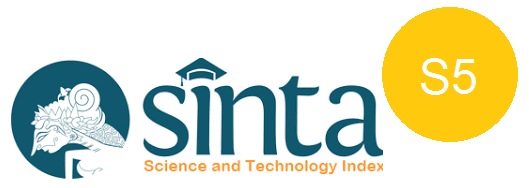LINGUISTIC REALIZATIONS OF THE ABSTRACTS IN INFORMATICS, COMPUTER SCIENCE & ENGINEERING, AND INFORMATION SYSTEMS JOURNALS
DOI:
https://doi.org/10.47313/pujangga.v9i1.2564Keywords:
Genre, Research article abstracts, Rhetorical Structure, Linguistic RealizationsAbstract
The abstract is now a required part of a Research Article (RA) for most scientific publications. It is recognized that the functions, linguistic realizations, and rhetorical structures of abstracts and RAs vary (Lores 2004). The study aims to examine how each step in RA abstracts is expressed linguistically. The data come from 30 RA abstracts taken from two Informatics, Computer Science & Engineering, and Information Systems in COMMIT (Communication and Information Technology) Journal and Khazanah Informatika, Jurnal Ilmu Komputer dan Informatika published in 2021-2022. According to Hyland's theory, the writers enumerated each move frequency of the rhetorical structure: Introduction (M1), Purpose (M2), Method (M3), Results (M4), and Conclusion (M5). The writers then examined each move's linguistic realizations, paying particular attention to the word tense and lexis. It was discovered that the category of "innovation in a field" was the most frequently used one in Move 1; "this" predominates in the category of deictic item in Move 2; and "use" and "show" are the most frequently used verbs in Move 3. Move 4 contains 25 that-complement phrases; At move 5, mixed results were found for each cohort. In Moves 1, 2, 4, and 5, the Present tense was used the most. In all the movements, the active voice predominated, and the passive voice was applied more in Move 3. The findings are a practical guide for beginning researchers conducting comparable studies.
References
Hyland, K. & Tse, P. (2005). Hooking the reader: A corpus study of Evaluative That in abstracts. English for Specific Purposes, 24(2), 123-139.
Hyland, K. (2003). Self-citation and self reference: Credibility and Promotion in Academic Publication. Journal of the American Society for Information Science and Technology, 54(3) ,251-259.
Hyland, K.(2000). Disciplinary Discourse: Social interaction in academy writing. London, UK: Longman.
Kanafani, A., Nurcik, A. B., Harisbaya, A. I., Qurratu’aini, S. F., Kurniawan, E., & Lubis, A. H. (2022). Rhetorical Move and Linguistic Features Comparative Analysis of Research Article Abstracts by Authors of Different Organizational Backgrounds. Proceedings of the Fifth International Conference on Language, Literature, Culture, and Education (ICOLLITE 2021), 595(Icollite), 129–135. https://doi.org/10.2991/assehr.k.211119.021
Karmila, K., & Laila, M. (2020). Rhetorical Moves of Abstracts: Investigating Abstracts Thesis of English Education Department Students in Surakarta. Jurnal Penelitian Humaniora, 21(2), 120–127. https://doi.org/10.23917/humaniora.v21i2.11208
Lambert V, Lambert C. (2019). Qualitative Descriptive Research: An Acceptable Design. Pacific Rim International Journal of Nursing Research [Internet];16(4):255-6. Available from: https://www.tci-thaijo.org/index.php/PRIJNR/article/view/5805
Lores, R. (2004). On RA Abstracts : From rhetorical structure to thematic organization. English for Specific Purposes, 23(3), 280-302. http://dx.doi.org/10.1016/j.esp.2003.06.001
Li, Y. (2011). A genre analysis of English and Chinese research article abstracts in linguistics and chemistry.
Nurhayati. (2016). Analysis Of Linguistic Realizations Of Abstracts On Asian IICLLTLC-2 2016., p. 184–193. http://openjournal.unpam.ac.id/index.php/Proceedings/article/view/205
Nassaji, H. (2015). Qualitative and descriptive research: Data type versus data analysis. In Language Teaching Research (Vol. 19, Issue 2, pp. 129–132). SAGE Publications Ltd. https://doi.org/10.1177/1362168815572747
Pho, P.D. (2008). Research article abstracts in applied linguistics and educational technologgy : a study of linguistic realizations of rhetorical structure and authorial stance. Discourse Studies, 10(2), 231- 250. http://dx.doi.org/10.1016/j.esp2003.06.001
Salager-Meyer, F. Corder. (1992). A text-type and move analysis study of verb tense and modality distribution in medical English abstracts. English for Specific Purposes, 11(2), 93-113.
Samraj, B. (2005). An exploration of a genre set: Research article abstracts and introduction in two disciplines. English for Specific Purposes, 24(2), 141-156. 2005.
Samraj, B. (2002). Disciplinary variation in abstracts: The case of wildlife behavior and conservation biology. In J. Flowerdew (Ed.), Academic Discourse (pp. 20-56). Harlow : Longman.
Santos, M.B.D. (1996). The textual organization of research paper abstracts in applied linguistic. Text, 16(4), 481-499.
Stotesbury, H. (2003). Evolution in research article abstracts in the narrative and hard sciences. Journal of English for Academic Purposes, 2,327-341.
Swales, J.M. (1990). Genre Analysis: English in academic and research setting. Cambridge, UK: Cambridge University Press.
Swales, J.M. (2004). Research Genres: Explorations and Applications. Cambridge, UK: Cambridge University Press.
Suntara, W., & Usaha, S. (2013). Research article abstracts in two related disciplines: Rhetorical variation between linguistics and applied linguistics. English Language Teaching, 6(2), 84–99. https://doi.org/10.5539/elt.v6n2p84
Tovar-viera, R. (2018). Linguistic realizations of research article abstracts written by Ecuadorian and North American academic authors. January, 82–99.
Tovar Viera, R. (2019). Rhetorical Move Structure in Abstracts of Research Articles Published in Ecuadorian and American English-Speaking Contexts. Arab World English Journal, 10(4), 74–87. https://doi.org/10.24093/awej/vol10no4.6








